Table of Contents
Amano Shrimp Overview
Amano shrimp is a good choice when considering an ideal tank cleaner. Well known by several names, including swamp shrimp, Yamato Numa Ebi, algae-eating shrimp, and Japonica Amano shrimp, this tank animal can clear algae from the aquarium. The shrimp is an aggressive food hunter and a powerful swimmer as well.
Popular among many hobbyists, the shrimp is exploratory. It also perches and hides behind plant leaves. Hunting for food is its favorite pastime. No wonder it matures within a short time.
This short information section about Amano Shrimp covers basic facts that you must know before housing this shrimp.
Amano Shrimp are freshwater invertebrates. They are quite popular among fish tank keepers because of their ability to clean the water. Takashi Amano, a well-known hobbyist, is the inspiration behind Amano Shrimps. Takashi Amano frequently uses these shrimps in his setup.

While Amino Shrimp are visually appealing, they also contribute to the tank’s cleanliness. In other words, they add charm to the tank. If you are willing to keep Amano Shrimp in your tank, scroll down to learn some interesting facts about them.
The information will help you figure out if an Amano Shrimp could be suitable for your tank:
| Information chart | Amano Shrimp |
|---|---|
| Scientific name | Caridina multidentata |
| Family | Atyidae |
| Care level | Easy |
| Temperament | Peaceful |
| Color | Light grey/brown translucent. Also, they can be found in light green or reddish-brown color |
| Lifespan | 2-3 years |
| Size | 2 inches |
| Diet | Omnivore |
| Minimum tank size | 10 gallons |
| Temperature | 68-86 °F/20-30 °C |
| Water conditions | 6.0–8.0 pH |
| Tankmates Compatibility | Guppies, betta fish, peaceful barbs, small tetras, and other small fish |
Amano Shrimp: Appearance
The Amano shrimp often adorns several colors. The most conspicuous one is light grey, and the other shades include green, reddish-brown, or light brown. Throughout the length of its body are dots and dashes that range from light blue to reddish-brown. At the top of its body is a long stripe that runs the whole length of its profile. On its head are two large eyes and long outstretched antennae. It has two elegant legs and a wide, translucent tail.
One unique factor about the shrimp is that its feed determines its color. Those that feed mainly on algae and detritus tend to be green. Amino shrimps that mainly eat fish food are reddish-brown. They can also mask themselves. If it disappears without a trace, it is likely to be hiding somewhere beneath the substrate or plants.
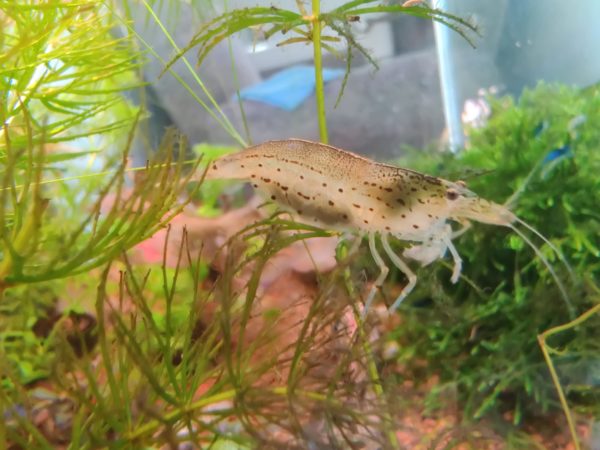
Their sizes vary due to many factors, including care and genes. When fully grown, they can measure anywhere between 1.5 to 2 inches. If properly cared for, they can live for three years or more.
Amano Shrimp are commonly known by various names, like Caridian Japonica, Japonica Shrimp, Algae Eating Shrimp, and Yamato Shrimp.
After Cherry Shrimp, Amano Shrimp is the most popular freshwater shrimp hobby. For keeping it, you need at least a 10 gallons tank. In addition, for Amano Shrimp to get several hiding spots, the tank must be heavily planted.
Amano Shrimp Lifespan
The typical lifespan of Amano Shrimp is between 2 to 3 years. At certain times, Amano Shrimp dies just a few days after being added to the tank. It usually happens due to stress and change in the environment.
If you offer proper care to Amano Shrimp, they can live up to 3 years. But if they find difficulty in adjusting, they might die sooner.
Amano Shrimp: Size
The typical Amano Shrimp can grow up to an inch on the lower end and two inches in length for larger specimens. So, if you want to buy it for your tank, get a smaller one because eventually, it will grow bigger.
Amano shrimp: Natural Origin and Habitat
The shrimp is native to South Central Japan. China and parts of Taiwan are known to host it. The shrimp is known to inhabit freshwater streams and rivers. These kinds of waters play a huge role in their life cycle.
The shrimp was discovered in Japan when Takashi Amano used them in an aquarium. Within no time, all the troublesome algae were gone. After the discovery, the news spread far and wide, with more hobbyists keeping the shrimp for tank cleaning purposes.
Amano Shrimp Care and Tank Set-Up
You can find true Amano Shrimp in Asia, China, Taiwan, and Japan. They like to live in large troupes within freshwater streams and rivers. But not all Amano Shrimp like living in freshwater. It’s the adult that usually lives there.
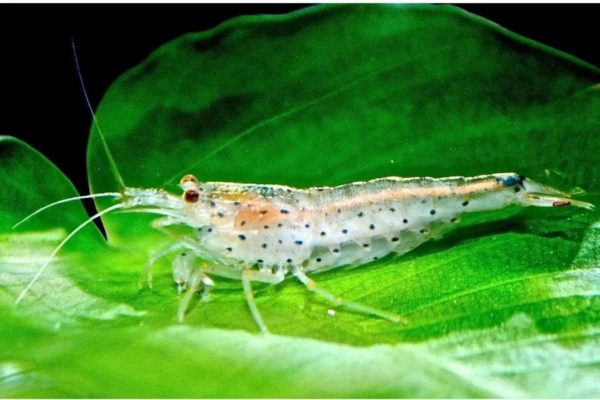
Since they are aggressive tank cleaners, most hobbyists house them with fish and other tank pets. They easily transform into meals for other predatory fish. You must be careful while choosing the tankmates.
Amano Shrimp: Tank Size and Specifications
This section talks about optimum tank size, minimum tank size, filter type, optimum tank shape, and how many Amano Shrimp you can keep together. So, stay tuned!
Optimum Tank Size for Amano Shrimp
The recommended tank size for Amano Shrimp is 10 gallons. It would be best if you did not get a tank smaller than this because the shrimps might not achieve their fullest length.
Tank Shape for Amano Shrimp
Amano Shrimp can be kept in species only or community tanks.
Filter Type
The absolute best filtration for Amano Shrimp is the sponge filter. But if you install a canister filter or hang-on-the-back filter, it could be dangerous. When the filter is working, shrimps can get stuck into it through the intake. And thus, they can die.
But when you use a sponge filter, it only traps waste and gunk floating on the water surface. It keeps the tank clean and shrimps alive. Also, Amano Shrimp can cling to the sponge and eat algae.
Substrate
The interesting thing about Amano Shrimp is that they don’t have any specific substrate requirement. You can add gravel, plant, or sand substrate, which will keep them happy. But avoid using any plant that is likely to decrease the pH level of tank water.
How Many Amano Shrimp Can You keep in a 10 Gallons Tank?
If you have a 10 gallons tank you can keep around 3-4 Amano Shrimps.
Water Parameters for Amano Shrimp
This section covers water temperature, pH level, water hardness, and other important parameters.
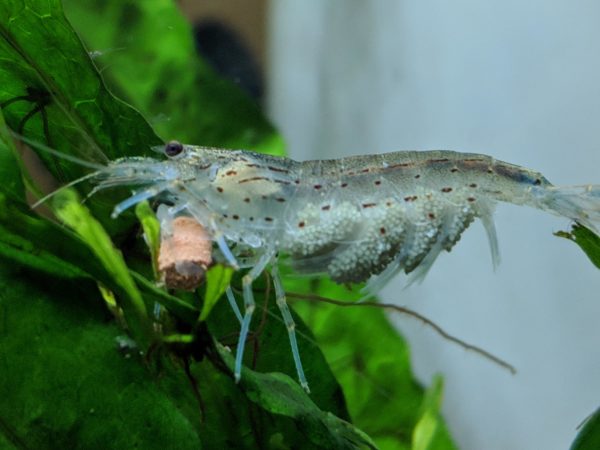
Water Temperature,
The ideal water temperature for Amano Shrimp should be between 73 and 78 F (23 and 27C).
Of course, a slight decrease or increase does not adversely affect the shrimp. All the same, a constant temperature is often recommended.
pH Level
The perfect water pH for Amano Shrimp can vary between 5.8 and 7.0.
A pH of more than 7.0 can lead to a lack of oxygen, forcing the shrimp to vacate the water. To avoid this, stick to the required pH.
Water Hardness
Considering the general hardness for the Amano Shrimp tank, it should be around ~6-8dkh. TDS should be at about 200ppm.
Amano Shrimp Tank Landscape
Here’s how you can quickly set up the Amano Shrimp tank.
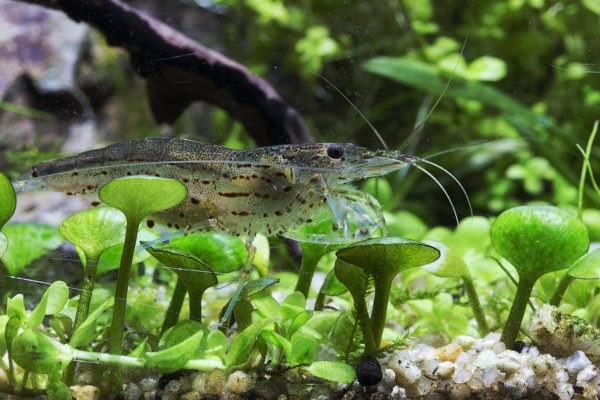
- A 20 gallon tank should accommodate at least 20 shrimps comfortably.
- Place pebbles at the bottom of the tank.
- Add fine sand and gravel to the substrate.
- Place rooted plants and floating ones to provide a nice cover for the shrimp. It helps it hide during moments when it wishes to be alone.
- Use a filter that offers a high water current. In their original habitat, they are used to high-moving waters.
- Standard lighting will be ideal.
Best Plants for Amano Shrimp Tanks
One of the best things about housing Amano Shrimp is that they like heavily planted tanks. That means you can add different plants and make it a little garden where these little guys can live peacefully.
Here’s a list of the best plants to add to your shrimp tank.
- Java moss
- Java fern
- Anubias and Anubias nana
- Cryptocoryne
- Dwarf lilies
- Vallisneria
- Water wisteria
- Utricularia Graminifolia
These plants can maintain the proper flow of light in the tank. Also, they oxygenate the water, make the tank look nice, maintain the correct pH balance, and keep the tank clean.
Worst Plants for Amano Shrimp Tank
While Amano Shrimp loves to be surrounded by greenery, there are a few plants that you must avoid adding to the shrimp tank. These are poisonous plants that can kill shrimps. Also, some plants can change the pH level of water.
Decorations for Amano Shrimp Tanks
You can decorate the Amano Shrimp tank with lots of little hide holes to retreat to after they molt. You can also add plant driftwood.
Lighting for Amano Shrimp Tank
When it comes to lighting, it’s best to use full-spectrum lighting for the shrimp tank. The healthy and vibrant lighting can benefit the shrimps because it can promote algae growth.
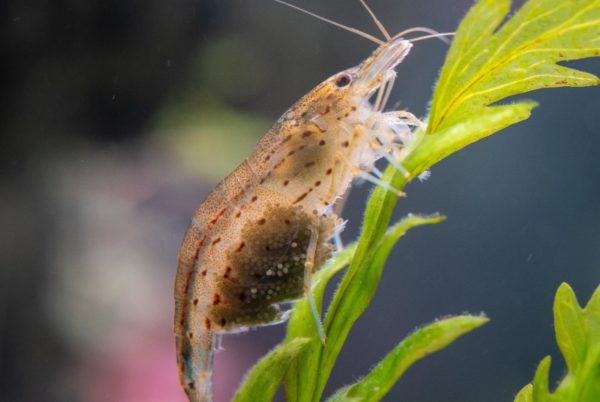
Nitrogen Requirement for Amano Shrimp Tank
Do not add copper to the water. If you need to use nitrate, you must use it modestly, as high amounts may spark a problem for the shrimp.
Keep in mind that wild-caught Amano Shrimp handle nitrate poorly. So, after cycling, the nitrate should be 0. Also, you should keep ammonia at 0.
Feeding Amano Shrimp
Through this section, you will learn how often you should feed Amano Shrimp and the best diet for them.
Best Diet for Amano Shrimp
While it is a scavenger that eats anything from food remnants to tank algae, there is still a need to provide sufficient food. Remember, it hunts for its feed-in its natural environment because it has its freedom. It is different in captivity as conditions are under tight control. The following feeds should do well for the Amano shrimp:
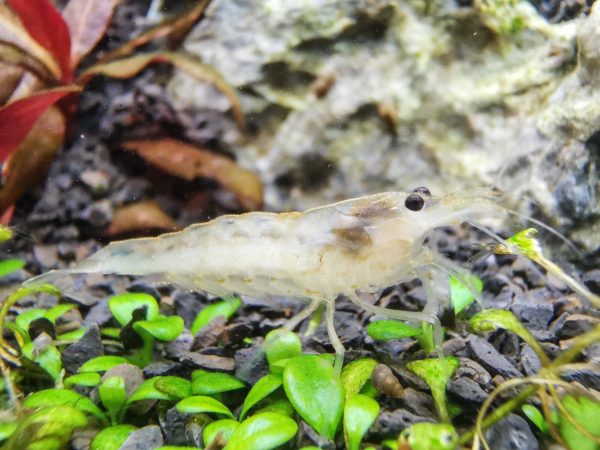
- Decaying plant matter
- Shrimp pellets
- Fish flakes
- Blanched spinach
- Raw zucchini
- Algae wafers
- Broccoli
- Cucumber
After offering feeds, you can remove the leftovers within 24 hours to avoid fouling the tank. When kept with other peaceful fish that are non-predatory, there is no need to feed the shrimp too often as it will devour any leftovers from the tank-mates.
How Often Should You Feed Amano Shrimp?
You can feed the Amano Shrimp 2-3 times a week. Overfeeding the shrimp can be deadly. Also, leftover food breaks down, which results in nitrate and ammonia spikes.
Amano Shrimp Behavior and Temperament
Usually, Amano Shrimps are gentle. They do not pick fights, nor do they trouble other tank mates. But they get slightly greedy during feeding time.
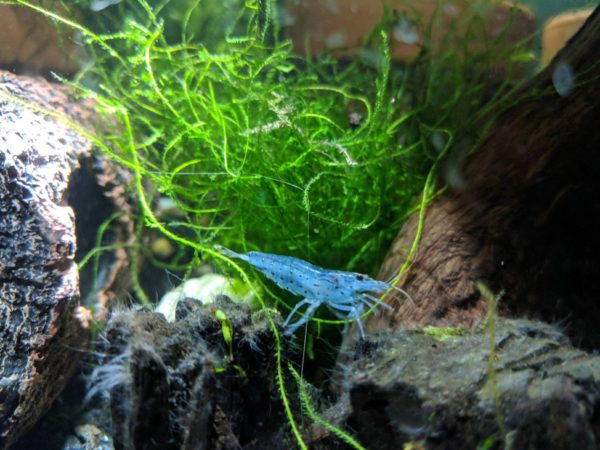
When Amano Shrimp moves, they like to create extra movement, which makes them fun to watch. They like to swim around in the tank but usually, they like to spend their time foraging fr leftover bits of food.
When an Amano Shrimp is molted, it regrows its exoskeleton by going to the back of the tank. Going back protects them from getting eaten.
Are Amano Shrimp Lone or Societal in Nature?
Amano Shrimps are social creatures that like living in large groups.
Amano Shrimp Tank Mates
Let’s discuss some good and terrible tank mates for these little guys.
Ideal Amano Shrimp Tank Mates
As you know, Amano shrimps are peaceful. They do not create trouble for other species that live in the same tank. Below are the best fish species you can consider keeping with Amano Shrimp.
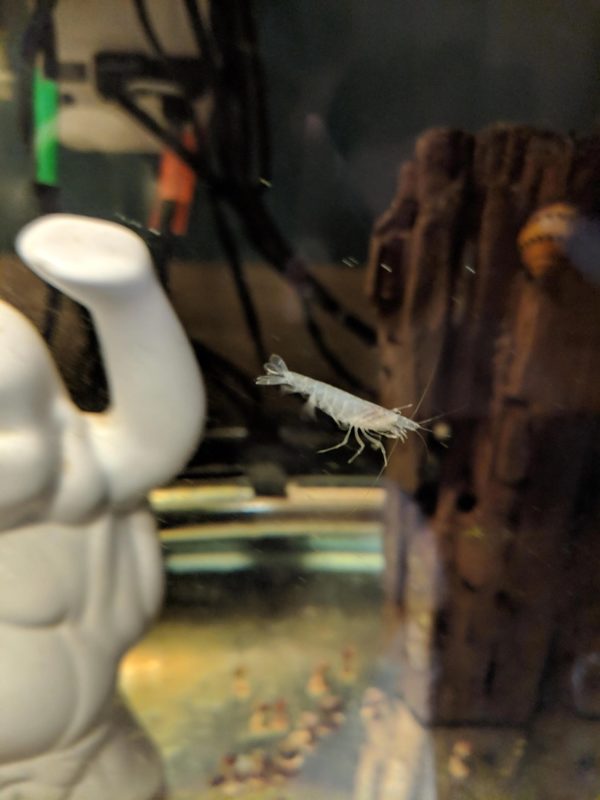
- Guppies
- Chili rasboras
- Platies
- Celestial pearl danios
- Zebra danios
- White cloud mountain minnows
- Harlequin rasboras
- Neon tetras
- Cardinal tetras
- Tiger Shrimps
Amano shrimps can easily coexist with fish like tiger barbs, discus, and bristlenose fish. If kept as a group, they are very lovely and lively.
Bad Tank Mates for Amano Shrimp
Here’s a list of bad tank mates that you must avoid keeping with Amano Shrimps.
- Pacu
- Goldfish
- Jewel cichlids
- Discus
- Angelfish
- Knife fish
- Silver dollar
You must avoid keeping any aggressive and large-sized fish with Amano Shrimps.
Breeding of Amano Shrimp
Distinguishing males from females is easy in Amano shrimps. However, breeding them in captivity is difficult as it requires certain hard conditions to meet in a standard tank. All the same, there is always the chance for trial. You can do the following things to have them breed:
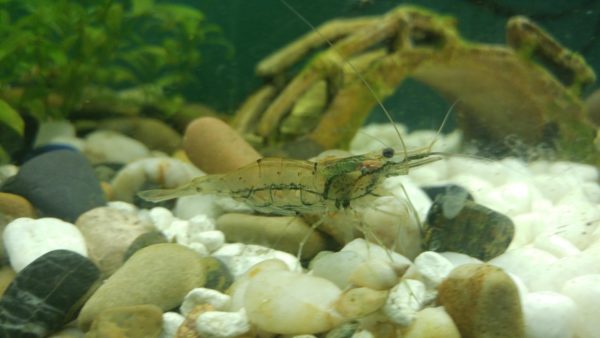
- For breeding, place them in a different tank.
- The female will release a pheromone into the water. It entices the male to pursue it. If the tank contains more males, they will most likely pile on top of the female in question. While many will do this, only one will fertilize her eggs.
- The female will then carry a “beg” with eggs inside it. The eggs may vary from 2 million to 4 million. These eggs are carried around for about 2-6 weeks. They (eggs) will be regularly cleaned and placed in individual nests.
- During the process of carrying, the tank should be extremely conducive. Ensure there is high oxygen content within the tank. If these conditions are unmet, the eggs are unlikely to hatch.
- The eggs begin to hatch. Some may not. The female then throws away those that do not hatch.
- The shrimp fry begins feeding actively from the time they hatch. Offer baby shrimp food by crushing yeast or vegetables. Being active eaters, they often mature quite fast.
Amano Shrimp: Breeding Level
Breeding Amano Shrimp in a house tank is not easy. Thus, their breeding level is difficult.
Amano Shrimp: Sexual Dimorphism
To distinguish between males and females, check their size. The males are slightly smaller than the females in size. On the other hand, females look much larger with bulging pleopods in their abdomens.
Amano Shrimp: Common Disease and Their Treatment
Amano shrimp are known to develop bacterial infections, parasites, fungal infections, and more.
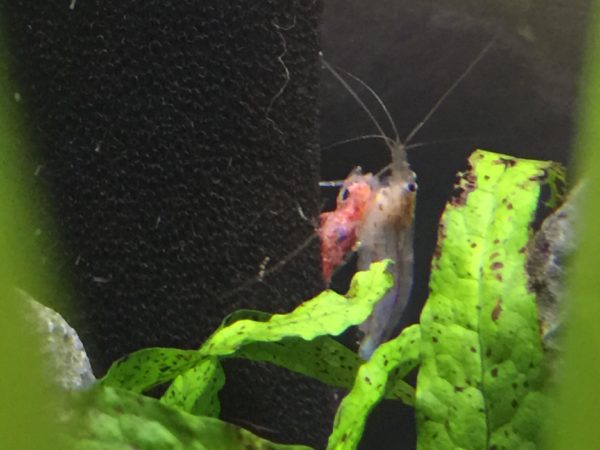
If your Amano shrimp has developed bacterial infections, you must perform bug water changes o a daily basis. You can also use a 3% Hydrogen Peroxide solution to treat the algae in the tank.
You can try a salt bath to treat parasites. Put one tablespoon of salt in a glass of water. Mix well and transfer the infected shrimp to the glass. After a few seconds, transfer the shrimp back to the tank from saltwater glass.
Facts About Amano Shrimp
- The Amano shrimp can hide for several days without availing themselves to be seen. If it disappears for some days, give it time, and it will eventually resurface.
- They are preyed upon by many fish types. House them only with friendly pets that will not tear off their body parts.
- Amano shrimp is an ideal tank cleaner. Instead of worrying about regularly cleaning a tank, place them with friendly fish and have a clean tank in return.
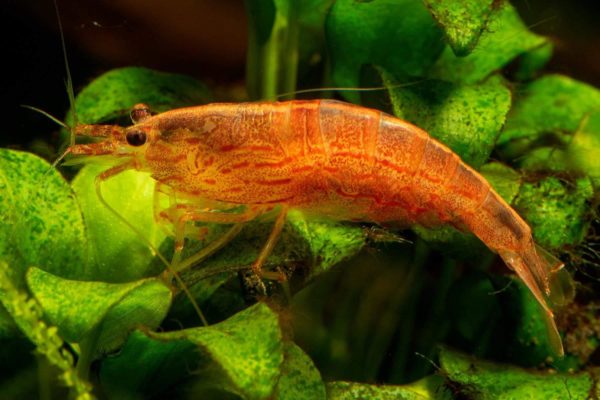
Are Amano Shrimp Right For You?
Honestly, Amano Shrimps are great algae eaters. That means if you keep them, they will keep the tank algae-free. Also, they are peaceful and do not show aggression. Not to mention that Amano Shrimps can adjust to various water types. Thus, you can consider keeping them.
Frequently Asked Questions
Are Amano Shrimps hard to keep?
You can easily keep Amano Shrimps as they are easy to care for and maintain. But they are difficult to breed in captivity.
How fast can Amano Shrimp grow?
These shrimps can achieve their full length in 3 to 5 months. If the environment is healthy, they will grow a lot faster.
Does Amano Shrimp need a heater?
One thing to keep in mind about Amano Shrimp is extremely particular about their water. Thus, you can install a heater to offer them a better living environment.
Do Amano Shrimp need a water pump?
If the water is properly oxygenated, you can skip adding a water pump to the Amano Shrimp tank. There are never any problems with shrimp coming to the water’s surface to gasp air.
Can Amano Shrimp be kept in a bowl?
If you do not have a fish tank, you can keep the Amano Shrimps in a bowl. But you must keep the bowl clean so that shrimps can live in a healthy environment.
Conclusion
Amano Shrimps can make a great addition to your tank because they eat algae. Also, these little fellas look great in the tank. If you are planning to keep them, get a 10 gallons tank. You can add different plants to the tank, such as Amano Shrimps and greenery. But you must never overfeed them as it can be deadly.
No related posts.
